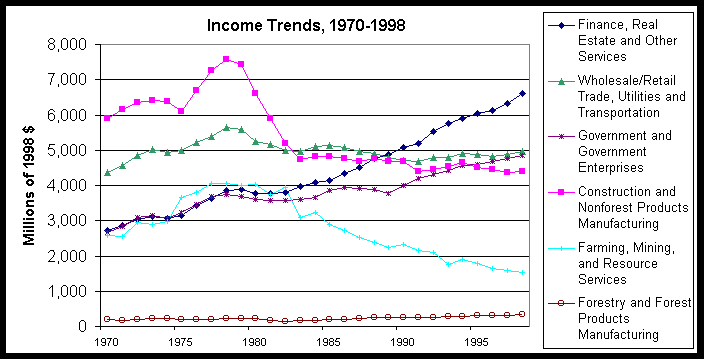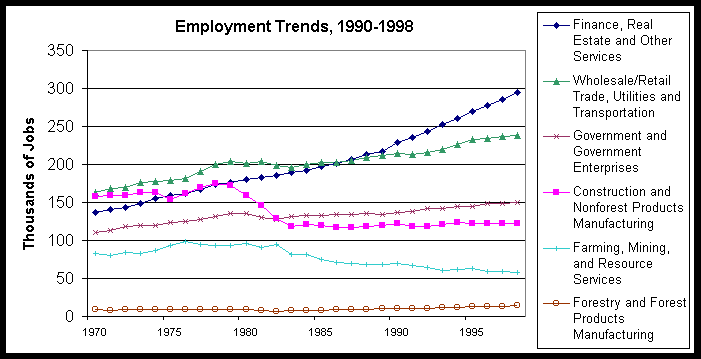
The Wilderness Society
The Monongahela National Forest and the West Virginia Economy
November 16, 2001
The economic importance of wild forest areas extends far beyond the raw material (timber) those areas could provide to the forest products industry. It includes the value of backcountry recreation, clean water and air, scenic beauty and wildlife habitat. And, it encompasses the development of rural communities as people are attracted to, or stay in, places that are clean, beautiful and where they have ample opportunities to connect with nature.
Discussions about the protection of roadless areas in the Monongahela National Forest should therefore include a clear picture of the West Virginia economy, including:
- the role of National Forest timber in West Virginia's timber industry,
- the role of the timber industry in the overall economy of West Virginia and
- the economic benefits associated with the full array of resources, including those available especially, if not exclusively, from wild forest lands.
How important is the Monongahela National Forest to West Virginia’s forest products industry?
Compared to overall timber harvest, the Monongahela National Forest is a minor source of logs for the West Virginia forest products manufacturing industry.
- Based on USDA Forest Service data, timber from the Monongahela National Forest supplies about 3.2 percent of the state’s timber harvest (USDA Forest Service 1999). The average 1995-97 cut from the Monongahela National Forest was 28.0 million board feet (MMbf), of which 20.9 MMbf was in sawlogs.
- USDA Forest Service estimates that inventoried roadless areas in West Virginia's national forests are about 19.6 percent of total National Forest acreage in the state. For 6.9 percent of this area, forest plan prescriptions already exclude road construction and reconstruction. Since many of these areas are already unavailable for harvest, and others are less productive than the average, removing roadless areas from the timber base will have a fairly small impact on future timber harvests.
- Meanwhile many states export some logs out of the state without any further processing. With every raw log exported, opportunities for value-added processing and West Virginia jobs are exported as well.
Do U.S. taxpayers subsidize timber harvest in the Monongahela National Forest? And why does it matter?
- The 1997 timber program for the Monongahela National Forest earned between $1,025,140 and $2,844,000, depending on what costs are included.
- Commodity program timber sales on the Monongahela National Forest generated revenues of $6,493,000 in FY 1997. The basic cost of the program was $3,649,000. Adding in the administrative costs ($359,927) and the portion of gross receipts returned to the state ($1,458,934), the total program costs are about $5,467,860.
- Rather than contributing to West Virginia's timber supply, the Forest Service (and, by extension, the U.S. taxpayers) would do better to direct resources toward programs, such as the Economic Action Programs, that encourage value-added processing, increased efficiency, and improved marketing of forest products. This would make it more likely that trees harvested in West Virginia could be profitably processed in the state, and would foster a more sustainable forest products industry.
But won’t increased timber harvest lead to more forest products manufacturing jobs?
No. Due to increased use of labor-saving technologies, cutting more trees does not necessarily translate into employing more workers.
- In Maine, timber harvest increased by 38 percent from 1977 to 1992, but jobs in the industry declined by 12 percent during the same period. Phillips (1996) found that, statistically, there is no relationship between timber harvest and forest products manufacturing employment.
- Examples from other regions support the same conclusion. Between 1970 and 1990, 1.8 million roadless acres within three Montana national forests were developed for timber harvest. During the same period, 2,310 timber jobs were lost in the six-county region surrounding these forests (a 31 percent drop) (Rasker 1994a).
- Nationwide, Rasker, Gorte and Alkire (1996) conclude that, with some short-term exceptions, "there is very little predictable connection between employment and public timber harvesting".
How important is timber to the West Virginia economy?
Timber-related industries represent a small percentage of the West Virginia economy, as measured by jobs and by personal income.
- In 1998, forest products manufacturing provided 1.6 percent of all jobs in West Virginia (US Bureau of Economic Analysis, 2000). Forest products manufacturing jobs increased by an average of 2.0 percent per year since 1970.
- US BEA reports that earnings in forest products manufacturing totaled 344.3 million in 1998, an increase of 2.6 percent per year (after adjusting for inflation) since 1970. Income for the state as a whole increased 1.7 percent per year over the same period. Forest products manufacturing earnings as a percent of total personal income for West Virginia rose from 0.8 percent in 1970 to 0.9 percent in 1998, but remained a small fraction of total earnings.
What ARE the biggest and fastest growing portions of West Virginia’s economy?
- Total personal income in West Virginia in 1998 was 36.57 billion. The biggest sources of income were Non-labor income (investment income, rental income and transfer payments, like Social Security and Medicare) at 40.8 percent, the Services industry with 15.5 percent, Government and government enterprises at 13.2 percent, and Nonforest products manufacturing with 8.3 percent (BEA, 2000).
- There were 877,900 full and part-time jobs in West Virginia in 1998, 16.6 percent of which were the jobs of self-employed persons. The industries employing the most people in the state are: Services with 252,839 jobs, or 28.8 percent of total employment); Retail trade (160,139 jobs and 18.2 percent), and Government and government enterprises (149,783 jobs and 17.1 percent) (BEA, 2000).
- Non-labor income grew by an average of 3.7 percent per year from 1970 – 1998. Self-employment grew by 1.7 percent per year. Other fast-growth industries include: Services - with increases of 3.1 percent per year in jobs and 3.5 percent per year in income; Retail trade with a 2.0 percent per year increase in jobs and a 0.7 percent per year increase in income, Finance, insurance, and real estate (up 1.5 percent per year in employment and 2.2 percent per year in income), and Construction with 1.3 percent per year more jobs and 0.5 percent per year more income (BEA, 2000).
But doesn’t the "service sector" offer only low-wage, dead-end employment?
- The service sector includes a wide range of industries, from "hotels and lodging places" to "engineering and management services." These industries employ many professionals, from engineers to doctors and architects, whose positions would be neither low-wage nor dead-end.
- Average earnings in several service industries, including health care ($34,528), legal services ($51,991), and engineering and management services ($27,080) compare favorably with the all-industry average of $25,837 and the forest products manufacturing average of $24,892 (BEA, 2000).
What does growth in non-labor income and in industries like services and finance, insurance and real estate have to do with the Monongahela National Forest?
Research from across the country has found that people and businesses locate where the quality of life, based in part on a clean natural environment and high quality recreational opportunities, is high. Retirees and "footloose" businesses (those not geographically tied down to raw material supply or output markets) especially can bring dollars and opportunities to high amenity areas.
- Public lands represent natural assets that provide communities with a comparative advantage over other rural areas in diversifying their economies. Public land management can contribute to diversifying local economies by de-emphasizing resource extraction and emphasizing management and budgets on labor intensive ecological restoration, road decommissioning, providing high-quality experiential recreation, and conserving habitat for the region’s biological resources.
- As noted by Freudenburg and Gramling (1994): "…it needs to be recognized as a serious empirical possibility that the future economic hope for resource-dependent communities of...the United States could have less to do with the consumption of natural resources than with their preservation."
- In a survey of eleven fast-growing counties across the U.S., Rudzitis and Johansen (1991) found that forty-five percent of long-time residents and sixty percent of recent migrants to counties containing wilderness indicate wilderness is an important reason for living in those counties.
- Rasker (1994b) found that entrepreneurs cite quality of life factors over "business climate" factors (cheap labor, low taxes, lax environmental standards) as reasons for locating and keeping their businesses in the greater Yellowstone region. (See also Power 1996.)
- The Maine Alliance and Maine Chamber of Commerce and Industry (1994) has recently identified Maine’s competitive advantages as quality of life, physical beauty, clean air and water, environmental management know-how, and forest resources.


How else do protected wildlands contribute to the economy?
The economic benefits of wildland range from the tangible and immediate, such as the enhanced value of real estate in proximity to protected areas, to the esoteric and the distant, such as the value of preserving species for the potential use and enjoyment of future generations. Some of these benefits are reflected in markets and can be quantified as prices. Others are not traded in formal markets and have no price. That does not mean, however, that they have no value, and all such values must be considered in assessing the economic importance of wild land.
- Real Estate Enhancement Value:
Protected land can enhance the value of nearby private property. In the area surrounding the Green Mountain National Forest in Vermont, land prices are higher in towns that contain wilderness, while land price decreases with distance from a wilderness boundary (Phillips 2000).
- Lower Public Service Costs:
Though many towns may express a concern about the impact of public lands on local tax revenues, it is net revenues that really matter. Open space typically generates more local tax revenue than the cost of the public services it requires – cows and moose don’t ride school buses.
Recent studies in Maine and the Adirondacks reveal that towns with more open space have lower tax rates (Brighton 1997) and that amount of protected land is not associated with higher or lower tax bills (Ad Hoc Associates 1996).
For federal lands, Payment In Lieu of Taxes or PILT payments augment local tax revenue. States also receive a share of timber and other revenues generated by National Forest management activities, and these funds have been used to help fund roads and schools at the local level. Legislation is pending in Congress, however, to decouple these payments from revenues and create a more stable system of fixed payments. In any case, according to a study of 100 counties in the Columbia Basin, Schmit and Rasker (1996) found that very few local governments are actually dependent on these revenue-based payments. The vast majority of those counties derive less than five percent of their total budget from those payments.
- Ecosystem Service Values
: Ecosystem services are those things provided by nature that man would otherwise need to provide for himself. They include air and water filtration, climate regulation, maintenance of biodiversity, scenic beauty and other benefits.
Water filtration is just one example. The US Forest Service estimates that 60 million Americans - more than one fifth of the population - get their water from sources with headwaters on a National Forest. Filtering that water is one example of the services we get "for free" from protected landscapes. Indeed, one of the principal purposes of the National Forests is to protect water supplies. The U.S Forest Service estimates that the National Forests supply 6% of the runoff east of the Mississippi River and 33% of the runoff in the west. At a very minimum, this water is worth $3.7 billion annually (Sedell, et al, 2000).
Carbon Sequestration is another. Mature fully-stocked forests sequester carbon to help slow the process of global warming. With carbon credits already exchanging for between $1 and $20 per ton around the world, carbon credits could be worth $300 to $600 per acre (Walls 1999).
Costanza, et al. (1998) estimate the value of ecosystem services for temperate forests like West Virginia’s at $122 per acre per year. Less than one tenth of this sum is due to raw material production (agriculture and forestry) and about one third is from all direct use values, including recreation. Thus, West Virginia’s forests can be said to be providing in excess of $80 per acre per year even if no one ever sets foot in them.
In a more recent study focused on wilderness in the lower 48 states, Loomis and Richardson estimate $150 per acre per year for carbon storage, climate regulation and waste treatment (filtering air and water).
- Passive Use Values:
These include option value (what it’s worth to preserve the option of future use), bequest value (what it’s worth to pass a resource unimpaired to future generations) and existence value (what it’s worth to preserve a resource that one has no expectation of using in the future). Loomis and Richardson estimate the passive use value of wilderness in the eastern U.S. as about $4/acre/year. Again, this value is produced before the first hiker puts on her backpack.
- Recreation Values:
Again from Loomis and Richardson, eastern wilderness produces about $44 worth of recreation per acre each year. And visitors to wilderness generate an additional $44 per acre per year of spending in nearby communities. That spending translates into support for one job for every 550 acres of wilderness. A National Sporting Goods Association survey estimates that participation in wilderness camping and hiking by residents increased 47.5 percent from 1990 to 1998, reaching 2,630 thousand visitor days of backpacking and 3,440 thousand visitor days of hiking in 1998.
- Scientific Value:
Aldo Leopold (1949) wrote that wilderness supplies us a "base datum of normality, a picture of how healthy land maintains itself as an organism." Wilderness is the control by which we can judge the impacts of our management on other parts of the landscape.
For more information, contact:
George Gay
Regional Director, The Wilderness Society
(404) 872-9453
Works Cited
Ad Hoc Associates. 1996. Property Taxes, Growth, and Land Conservation in the Adirondacks. Elizabethtown, NY: The Adirondack Council.
Brighton, D. 1997. Open Land, Development, Land Conservation and Property Taxes in Maine’s Organized Municipalities. Salisbury, VT: Ad Hoc Associates, commissioned by Maine Coast Heritage Trust
Costanza, et al. 1998. The value of the world’s ecosystem services. Ecological Economics 25:3-15.
Duffy-Deno, K. T. 1998. The effect of federal wilderness on county growth in the intermountain western United States. Journal of Regional Science. 38(1): 109-136.
Freudenburg, W.R. and R. Gramling. 1994. Natural resources and rural poverty: A closer look. Society and Natural Resources. Vol. 7.
Irland, L. 1999. Wood Flows in New York, Vermont, New Hampshire, and Maine, 1997 with Recommended Monitoring System. Report to the Northeast Foresters Association. Winthrop, ME: The Irland Group, September.
Leopold, A. 1949. Wilderness. In A Sand County Almanac. Oxford: Oxford University Press.
Loomis, J. B. and Richardson, R. In Press. Economic Values of Wilderness in the United States. Fort Collins, CO: Dept of Agricultural and Resource Economics, Colorado State University.
The Maine Alliance and Maine Chamber of Commerce and Industry. 1994. Charting Maine's Economic Future. Augusta, ME: Maine Chamber of Commerce and Industry, January.
National Sporting Goods Association. 1990-1998. Sports Participation State-by-State. Mt. Prospect, IL. NSGA.
Phillips, S. 2000. Windfalls for wilderness: land protection and land value in the Green Mountains. In Cole, D.N. and McCool, S..F. Proceedings: Wilderness Science in a Time of Change. Proc. RMRS-P-000. Ogden, UT: U.S. Depart. of Agriculture Forest Service, Rocky Mountain Research Station.
Phillips, S. 1996. Governor speculates on the economic impact of citizen’s initiative. Washington, DC: The Wilderness Society, August.
Power, T.M. 1996. Lost landscapes and failed economies: the search for a value of place. Island Press, Covelo, CA.
Rasker, R. 1994. Jobs and Wildlands: Development of Roadless Areas and Employment Trends in Six Counties in Northwestern Montana. The Wilderness Society, with data from U.S. Forest Service, Desktop GIS Roadless Database.
Rasker, R. 1994b. A new look at old vistas: The economic role of environmental quality in western public lands. University of Colorado Law Review 65:369-99.
Rasker, R., Gorte, J. F., and Alkire, C. 1996. Logging National Forests to Create Jobs: An Unworkable Covenant, Washington, DC: The Wilderness Society.
Rudzitis, G. and Johansen, H. 1991. How important is wilderness? Results from a United States survey. Environmental Management 15(2): 227-233.
Sedell, J., et al. 2000. Water and the Forest Service. Washington, DC: USDA Forest Service, FS-660.
US Bureau of the Census. 1997. County Business Patterns 1994 & 1997. Washington, DC: U.S. Department of Commerce.
U.S. Bureau of Economic Analysis. 2000. Regional Economic Information System CD-ROM. Washington, DC: U.S. Department of Commerce.
USDA Forest Service. 1996. National Summary: Timber Sale Program, Annual Report, Fiscal Year 1995. Washington DC: U.S. Department of Agriculture, Forest Service. December, 118 pp.
USDA Forest Service. 1997. National Summary: Forest Management Program, Annual Report, Fiscal Year 1996. Washington DC: U.S. Department of Agriculture, Forest Service. December, 129 pp.
USDA Forest Service. 1998. National Summary: Forest Management Program, Annual Report, Fiscal Year 1997. Washington DC: U.S. Department of Agriculture, Forest Service. July, 143 pp.
USDA Forest Service, 1997. Forest Inventory and Analysis: Timber Product Output, Timber Removals Database Retrieval System. srsfia.usfs.msstate.edu/rpa/tpo.
Walls, J. 1999. Carbon sequestration: making sustainable forestry pay. In Practitioner: Newsletter of the National Network of Forest Practitioners, 13: 6-7.



